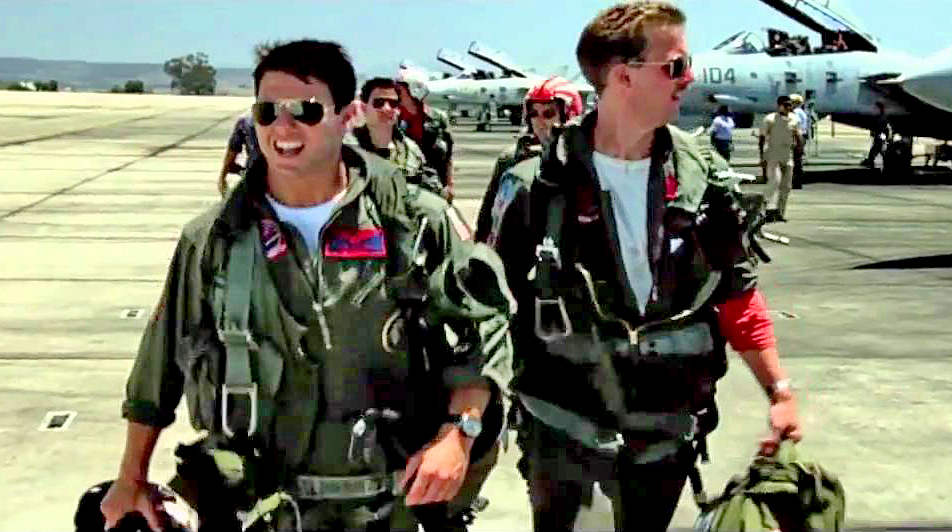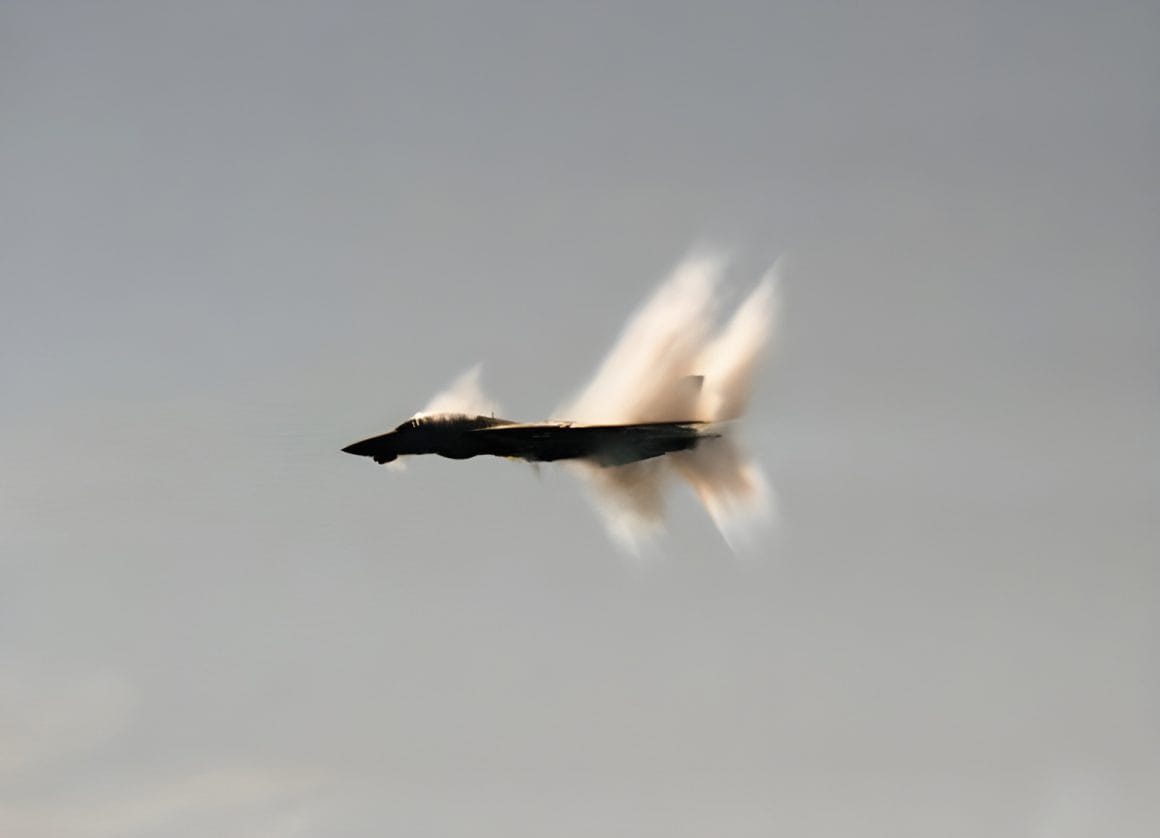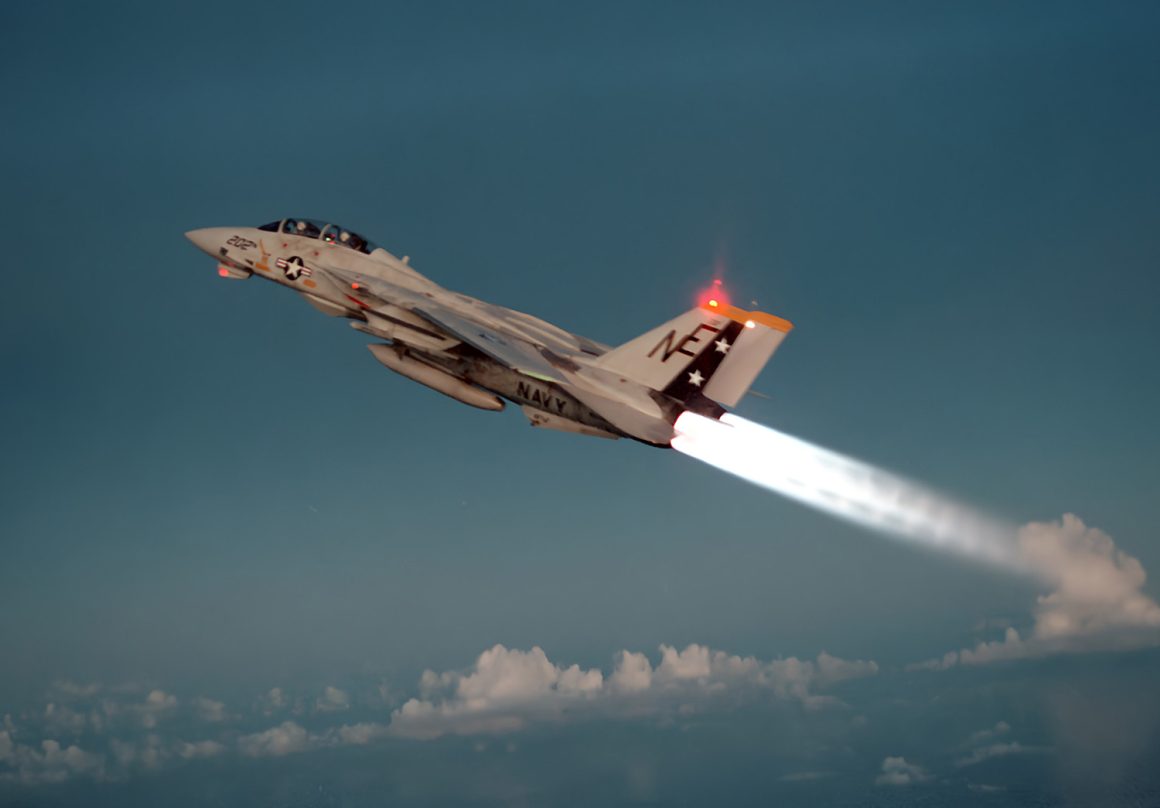When the movie TOP GUN was released in 1986, your author was a fourteen-year-old freshman in high school. I’d been a nut for things with wings for right around four years, and was eager to see the flick. Needless to say, after first taking it in, I was blown away.
TOP GUN cemented my interest in Naval Aviation and increased my fascination with the Grumman F-14 Tomcat. Almost to the point of obsession.
I wanted to know as much about the Tomcat as possible. So I began to seek answers to all the questions, including: what is the F-14’s Top Speed?
Do You Feel the Need?
Nowadays I watch that movie while wearing a couple’a different hats. The serious military aviation enthusiast in me cringes at certain points of the story. But the fourteen-year-old is still inside, somewhere. Both he and the serious guy gaze wide-eyed, and marvel at the stunning aerial cinematography.
We both revel in the overall atmosphere of awesome embodied in the film. And the high school kid still gets a kick outta the silly but witty banter. (Truth be told, so does the serious guy.)
Of all the the one-liners and catch-phrases to come outta that flick, one soars high above the rest. Or maybe I should say, it speeds further ahead of the rest. Yeah, you know which one I’m thinkin’ of. And that leads me back to the topic of this-here little ramble.

What Was the F-14’s Top Speed?
As with many such questions, the answer is, “it depends.”
An aircraft’s performance, specifically that of its power plant, can change in varying atmospheric conditions, especially with changes in temperature. Barometric pressure and humidity are also factors.
The F-14 family utilized two different engines: the F-14A was powered by two Pratt & Whitney TF30s. The F-14A+/F-14B, and F-14D were each powered by a pair of General Electric F110s.
Less quirky and more reliable than the TF30, the F110 also had a good bit more ‘oompf’; more thrust. But the key advantages of this increased thrust lay more within the regime of acceleration than of top-end speed. The F110-powered jets may have been slightly faster, but it didn’t really matter, as will become evident a bit later.
So, Grumman’s advertised top speed for all F-14s was Mach 2.34 at 40,000 feet; that’s 1342 knots, or 1,544 mph. At sea level, the max speed was given as Mach 1.2, which works out to 792 knots or 912 mph.
But was Mach 2.34 really the F-14’s Top Speed?
Nope. It wasn’t.
A fella named Charlie Brown was a test pilot for Grumman, and worked on the F-14 program. He served both as a pilot and as part of the design team. From an article titled ‘Tales of the F-14’ from the September 2006 ish of Air & Space Magazine, he is quoted:
“The [Navy] specs called for Mach 2.34. We actually tested the airplane for Mach 2.5. I flew it 2.5 a couple times.”

And there you have it. Words from someone who had ‘been there and done that’. ‘Tis anecdotal proof, sure… which I know that some are inclined to take with a dose of salt.
So, if you don’t wanna take Charlie’s word for it alone, how about Dave Andersen? He was a Radar Intercept Officer (RIO) in Tomcats from 1983 to 1992. Sometime back, Dave made a comment on a post on Quora describing his time as a career GIB (Guy In Back) in F-14s. Here’s a relevant excerpt from that comment where Dave relates what happened during a test flight:
“That jet accelerated like it was blasted out of a cannon. In maybe 50 seconds we went from about 400 knots and reached the advertised top speed of Mach 2.34, and the jet was still accelerating. I’m sure she would’ve gone past 2.5 Mach if we’d let her, but backed off at that point because we were getting close to “bingo” fuel state.”

Was Speed the Top Priority?
Dave Andersen’s comment indirectly brings up a good point about flying fast in a gas-guzzling jet fighter. And that is that there’s a price to pay, and an inevitable tradeoff between speed and endurance.
Dave indicated that the main reason they did not keep going was because they were ‘bingo’ fuel. Flying fast in an F-14, or any other similar jet, requires use of the afterburners, and that means markedly increased fuel consumption.
Ward Carroll, another F-14 RIO, addresses this in one of his YouTube videos:
“Generally, during tactical intercepts we’d be flying around at 350-400 knots. So the fuel flow at that air speed, at, say 25,000 feet, would be 4,000, 4,500 max pounds per hour. So that’s 9,000 pounds per hour in a jet that can hold 16,200 pounds without tanks and 20,000 pounds with tanks. Now, as soon as you go into afterburner, now you’re consuming gas at a rate of 4,000 or 5,000 pounds per MINUTE. You will run out of gas fast; you have to be very judicious about your use of afterburner.”
What all’a that means is that the top speed of the F-14, or comparable jets, doesn’t really matter much. Such high speeds are of relatively limited use in most combat situations, and flying that fast burns too much gas.
So, What Exactly WAS the F-14’s Top Speed?
How many times have you read or heard a pilot or aircrew say something similar to what Dave Andersen did? “We probably could’a gotten more outta the bird.”

All aircraft have their stated limits; limits that can often times be exceeded. If Charlie Brown’s claim is to be believed, then the F-14’s top speed was at least Mach 2.5. Dave Andersen’s claim certainly seems to support that.
It will likely never be known how fast an F-14 could truly fly. But it’s this guy’s opinion that the Tomcat’s top speed was a good bit more than Mach 2.5.
I’ll end with this; and it’s the fourteen-year-old in me that’s tappin’ the keyboard right now. All practical considerations aside, ‘Charlie’ in TOP GUN summarized things very nicely when she said, “You’re not going to be happy unless you’re going Mach 2 with your hair on fire”.
